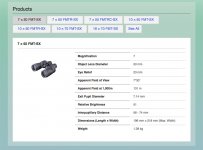WJC
Well-known member
Frequently, I see folks raving about this or that binoculars excellent collimation. Tonight, I came across a post on Cloudy Nights wherein the poster was declaring that a certain binocular had "absolutely zero collimation error."
Therefore, I would like to declare that having collimated thousands of binoculars and having read numerous scientific and technical papers on the subject:
THERE HAS NEVER BEEN A BINOCULAR MADE THAT HAS HAD ZERO COLLIMATION ERROR! NEVER! Nor, can there be.
Tiny? Yes.
Imperceptible? Yes.
Inconsequential? Yes.
ZERO? I have some oceanfront real estate to sell just north west of Wichita, Kansas for sale at a good price.
I try very hard to keep from spouting more that I know. I don't always succeed, but I do try. I wish others would try as hard. :cat:
Bill
Therefore, I would like to declare that having collimated thousands of binoculars and having read numerous scientific and technical papers on the subject:
THERE HAS NEVER BEEN A BINOCULAR MADE THAT HAS HAD ZERO COLLIMATION ERROR! NEVER! Nor, can there be.
Tiny? Yes.
Imperceptible? Yes.
Inconsequential? Yes.
ZERO? I have some oceanfront real estate to sell just north west of Wichita, Kansas for sale at a good price.
I try very hard to keep from spouting more that I know. I don't always succeed, but I do try. I wish others would try as hard. :cat:
Bill
Last edited:




